This whole Coronavirus crisis put us, as LegoⓇ Serious PlayⓇ facilitators, apart in a situation we never experienced, not being able to do what we love, to solve problems and inspire organizations to create a transformation.
Despite this situation, thanks to the amazing LegoⓇ Serious PlayⓇ community, a lot of experienced facilitators started to share experiments to help the methodology growth, aiming to help all companies that have been so cruelty impacted with this crisis. This is one of the superpowers that an OpenSource community has.
For this reason and after several online workshops, I decided to write this article sharing my experience, insights, tools, tips and agenda of how to run an online LSP workshop with a shared model.
I have to say that I’m quite experienced in working and managing teams and workshops online due to my background in technology as IT lead and IT project lead. Indeed, I ran several LSP online workshops before the COVID crisis, using the methodology as a qualitative research technique within a Design Thinking Project, so this helped me a lot to design the online sessions.
The structure of the article is the following:
- Preparation
- Agenda
- Workshop
- Feedback from attendees
- Conclusions
Preparation
Preparing a workshop is fundamental, either online or offline because you have to take care of many things, directly and indirectly related to the workshop. In an online scenario, some things are not present like, venue, tables, etc, but you have others to take care of like, internet problems, online tools to use, etc.
One very important thing running an online workshop is being so careful with the flow of the session, to create the correct mood, and more importantly, to be able to make the users forget about the online environment and focus on the goal and experience.
Here you have things to take care of preparing an online LSP workshop:
- Generate engagement and change the mood:
Sometimes could be difficult to bring all the attention to the room to be focused on the workshop to achieve the goal, this is why it’s so important to create the right environment. For doing so, I learnt from IDEO and other big companies the importance of starting with an Improv, check-in or warm-up exercise. You can choose the exercise relating it to the workshop. Apart from that, I always finish the online sessions with a selfie, where attendees choose a topic and have to perform it for the selfie. This is something I learnt from IDEOU, being a Design Thinking Alumni Coach.
- Video Conference software:
After many years using it, I always use Zoom because it has a lot of amazing features like recording, whiteboard, share music/audio, poll, and breakout rooms to split people into teams.
- Music:
I always use music during the Individual building in all my events because it helps me to create the right mood in every moment of the session and helps to generate an incredible engagement.
Once I have designed the agenda and the activities, I create a playlist choosing the appropriate songs for every exercise. Music is very helpful to create a correct flow during the session.
- Present slides and talk with attendees:
Reflect on the moments during the session where you want them to get information from you and the support of slides and when you want them to see you in a full-screen format to pay attention to something, or because you want them to talk between them. In these cases, it’s important people can see the faces of others, not a slide and faces in small squares.
- Moments working in teams:
Reflect on which moments attendees need to work in teams (Breakout rooms in Zoom) and when you need everyone in the “main room”.
- Tools and material needed:
I usually bring my own bricks to the sessions to run an LSP workshop. Now, being online, you have to be sure that every attendee has bricks to play.
Regarding the tools, apart from Zoom, I use Google Jamboard to upload the pictures from the workshop. Sometimes I use Padlet as well. I love these two tools because they are very easy to use for the attendees and have everything you need (uploading pics, markers, sticky notes, etc). Moreover, you can give access to these tools even not being registered.
- Bricks:
Usually, I run the LSP sessions with my bricks, mixed and I set them on every table. Having an online LSP workshop you have to decide if everyone is going to have the same bricks or not. Having the same bricks means that the client has to buy the material, having an extra cost but will be easier to build the exact models. I ran the online workshops with the attendees not having the same bricks, reducing the cost for the client and having great extra takeaways doing so that I’ll introduce in the Workshop and Conclusion section of this post.
- Set up:
I use my laptop to present and share music and an Android tablet for having the agenda of the workshop and as a backup for the Zoom connection. Every device is connected with different internet connections, one with ADSL and the other with mobile data.
- How attendees are going to see the models:
During the session, attendees upload the pictures of their individual models to Google Jamboard and place a sticky note with the main insights from the story. All the attendees have access to this Jamboard Canvas so can see the models and insights to facilitate the conversation.
- Who is in charge to build the Shared Model:
I decided to have only one person on the team being in charge of building the shared model. With this, you increase the communication within the team and generate more engagement and empathy, building the ideas of others through your hands. Ask the person in charge of the shared model to have a backup internet connection (ADSL and Mobile data). You have a more detailed explanation in the Workshop and Conclusion section of this post.
- How are you going to record the session:
For this feature, I use Zoom that’s integrated into the solution. If you don’t use Zoom, you can use Quicktime to record the screen and sound.
- Information in advance to the attendees:
You should send instructions to the attendees in advance, like Zoom link, the kind of tools they are going to use, if they need to be registered to use the tools, tool links, bricks, who is going to be in charge of the shared model, etc. One of my instructions is to install Google Jamboard in their smartphones to facilitate the task of uploading the picture to the canvas.
Ask the participants to have a backup internet connection (i.e. Adsl + mobile data) to secure the workshop experience.
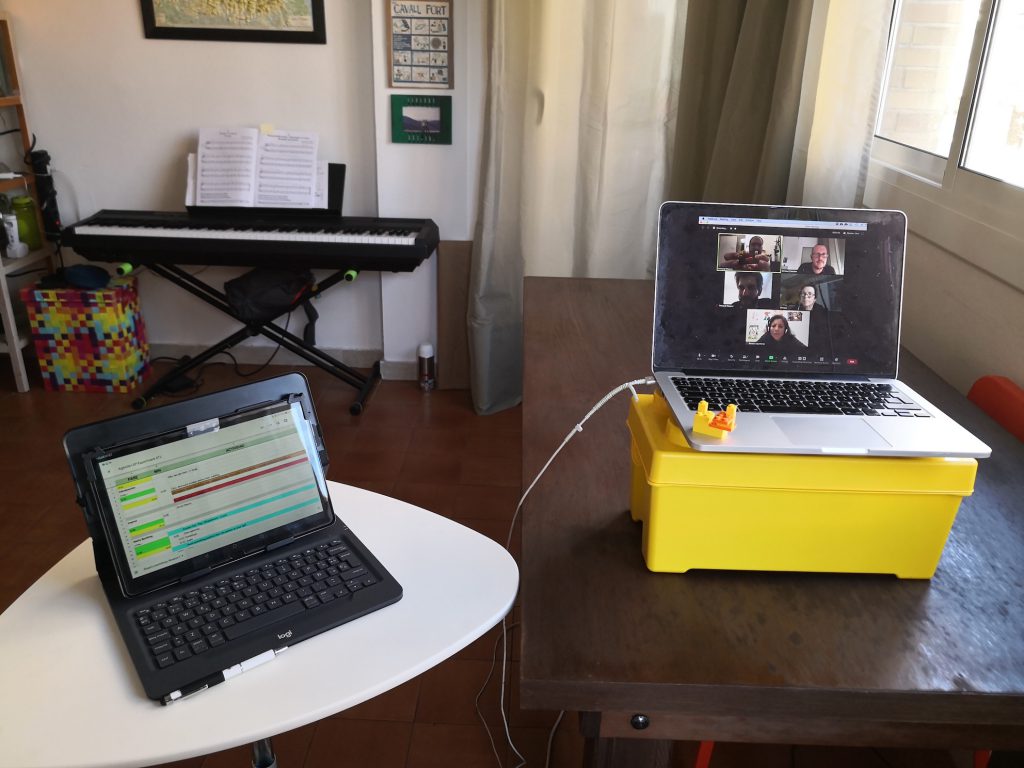
Agenda
The challenge for these online workshops was:
How Might We reimagine usual situations that stopped during this COVID crisis and shouldn’t continue in the same way in the future?
(i.e. too many flights, stressful and rush life, etc)
This was the agenda structure of the workshops:
- Workshop & challenge introduction
- LegoⓇ Serious PlayⓇ introduction
- Improv exercise, Dance with me:
Choose one of the attendees to be the leader, play music and the leader has to dance, move, perform with the rhythm of the music and the rest of the attendees have to imitate the movements. Change the leader every 20 seconds (approx).
- Skills Building:
- Build a tower
- Explain this: (Play / Experiment / COVID)
- Build something positive you like from the person you have on your right
- Individual models
- Build individual models reimagining how these situations that stopped with the COVID crisis should be in the future
- Share stories
- Questions
- Upload pictures and write insights on sticky notes on Jamboard
- Reflections
- Extension or expansion
- Share stories
- Questions
- Upload pictures and write insights on sticky notes on Jamboard
- Reflections
- Build individual models reimagining how these situations that stopped with the COVID crisis should be in the future
- Shared model
- Build the shared model of the key reimagined situations
- Recap of the model and insights
- Share story
- Level of agreement
- Upload pictures and write insights on sticky notes on Jamboard. Take pictures from different angles and have a panoramic picture.
- Reflection of the session
- Feedback from the session
- Selfie
Workshop
All these online workshops I ran experimenting with Shared Models were with a maximum of 5 people, to create a safe place to experiment and be completely focused on the experience.
As starting improv exercise, I used the “Dance with me” because I wanted to boost the energy of the team, create a happy moment and transmit from the beginning the feeling that this session is going to be different.
Individual Models
The flow of facilitating online individual models is quite similar to offline. The only thing is to do the reflection after uploading the pictures to the canvas, so everybody can see the models and insights after the questions and before the reflection.
In online workshops, It’s very important to ask attendees to use a pointer to show in which part of the model is their story, seeing where the story is placed in the model.
Observe the attendees’ body language (arms, face, gestures, etc) is more important than ever. Who is lost, who is surprised, who is playing with the smartphone, etc. It’ll help you with your facilitation.
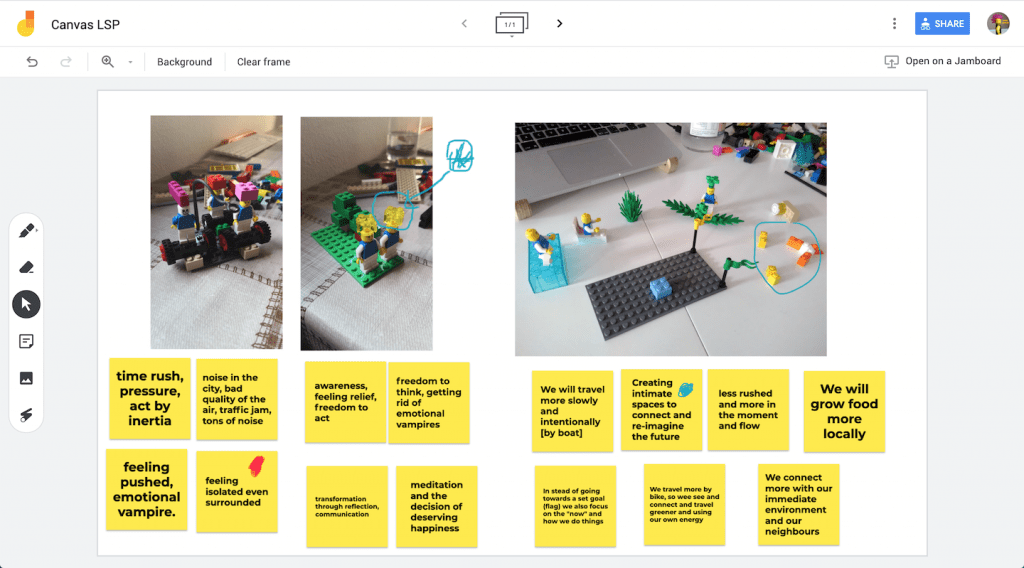
Shared Model
Pose carefully the instructions for building the shared model. I recommend, like during an offline workshop, to have the support of slides with the instructions.
After explaining how it works, explain who is in charge of the shared model and how the building is going to work.
The idea is that the team has to decide which insights are going to include in the shred model, why and how they are related.
In this case, having every attendee different bricks, the team decides what to include in the shared model and team members give the instructions about how to build the concepts and metaphors to the person in charge of the shared model (builder) with the bricks she/he has. Encourage the builder to look for bricks she/he has to explain this concept/metaphor.
This could take a little bit more time compared with offline workshops but you’ll get amazing results.
Benefits from building one online shared model having different bricks:
- Increase even more team communication
- Awareness of the importance of how team members give instructions
- Building the metaphors of others helps to empathise with colleagues, feeling the ideas of others in your hands
- Building the metaphors of others helps to continue ideating and building on the ideas of others.
- There are more understanding and agreement within the team.
- There is a big focus on the concepts and meanings of the metaphors.
- The team has a tremendous sense of building together
- More sense of co-creation within the team
- Generates a big team cohesion
Like in offline workshops, be aware of the attendees that don’t participate and encourage them to participate and give instructions.
Check if people feel comfortable with everything built under team instructions, specifically these that come from their individual models.
Once the team finishes the shared model, do a recap of the concepts within the models. You can ask the person in charge to start sharing the story, using a pointer.
If you want to ask another participant to share the story or they decide a different person to start sharing, recommend always to the person in charge of the model to point to the part of the model where the story is while the colleague is explaining the story.
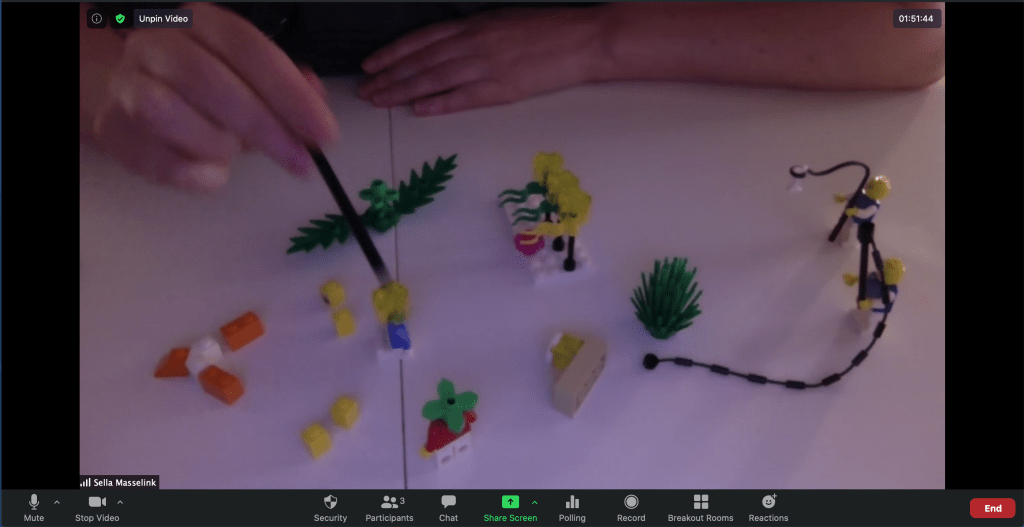
Feedback from the attendees
Here you have some feedback from the attendees after experiencing an online LSP workshop with a shared model. Some of them already attended offline LSP workshops with a shared model.
- Experienced user: “I have the feeling the team has a great advantage in building the shared model offline and having different bricks. I have the feeling that we really were building together and the power of building new ideas increased”.
- Experienced user: “I had the sense of building something shared between my team, giving instructions to the builder, even having an agreement of the instructions to give”.
- Builder user: Being the builder, I had the feeling of responsibility on what I build for the team and I like it. This helps me to encourage the team to give me the instructions to build.”
- Experienced user: “You can achieve as good insights having an offline LSP workshop as in an online workshop”
- Experienced user: “I noticed no difference in the experience and goal achieving between an online or offline workshop”
- “It’s easier to build on top the ideas of others”
- Experienced user: “It was easier to build less abstract concepts during the online workshop, you have to be more aligned with the team and know what exactly the builder has to build.”
- “It was so easy and comfortable to give instructions to the builder to build my concept. Indeed sometimes I had the feeling that they were increasing the power of my concept”
- Experienced user: During the shared model, the builder misunderstood my instructions building one of my individual concepts and, in the end, after some refinement and agreement, the final solution was even better than the first idea.”
- “Everyone had a strong sense of ownership with the shared model”
Conclusions
I never thought about giving a LegoⓇ Serious PlayⓇ workshop with a shared model online and now, after all these experiments and feedback from the users, you can see all the benefits from it. Even having the feeling that the teams can achieve the goal in the same way than in an offline workshop with amazing results and with great lateral achievements like team communication and empathy.
The success in an online workshop depends on having a correct flow and easy-to-use tools, to forget about the tools they are using and focusing on the experience and goal.
Not having the same bricks can make you think that is going to be very difficult, because the builder maybe can not build the exact individual model, and that will be more challenging or even impossible to build the shared model, but is quite the opposite, generate even more conversation, increase the feeling of teamwork and increase the agreement and alignment.
Apart from this, users not having the same bricks reduce the cost of the project.
For scaling online LSP workshops with more attendees, you need to split attendees into teams and the best way to do it is with the Breakout Rooms Zoom feature. I’ve been using it for years with online Design Thinking workshops and a very powerful and easy to use and jump into the different teams.
Thanks a so much to all the attendees to be so keen to experiment with me to create something to share with the LegoⓇ Serious PlayⓇ community.


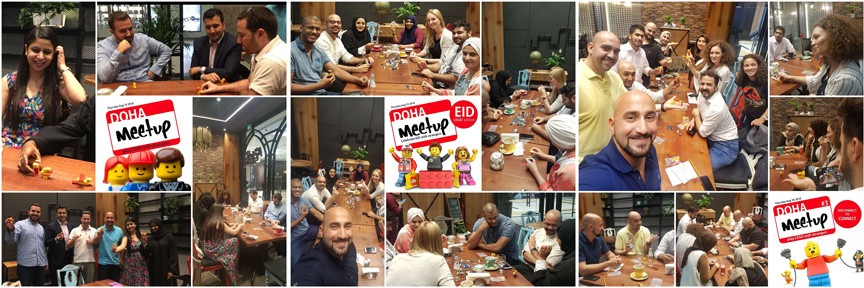


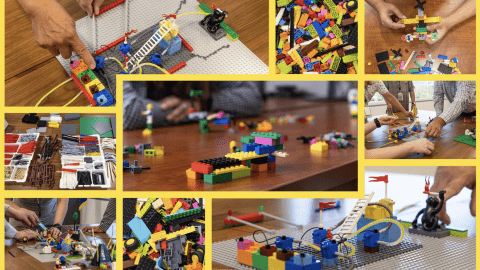

 Become a LEGO Serious Play facilitator - check one of the upcoming training events!
Become a LEGO Serious Play facilitator - check one of the upcoming training events!